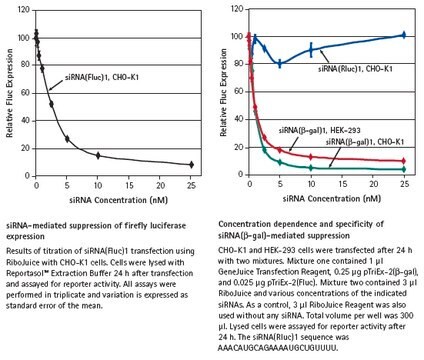S1452
MISSION® siRNA Transfection Reagent
Sinonimo/i:
MISSION® siRNA Transfection Reagent
About This Item
Prodotti consigliati
Nome Commerciale
MISSION®
Forma fisica
aqueous solution
Condizioni di spedizione
wet ice
Temperatura di conservazione
2-8°C
Descrizione generale
Effective gene silencing and reduced off target effects are achieved using a low siRNA concentration (1nM). The siRNA Transfection Reagent is provided as a sterile solution, and is compatible with serum and antibiotics.
Altre note
Note legali
Prodotti correlati
Avvertenze
Warning
Indicazioni di pericolo
Consigli di prudenza
Classi di pericolo
Flam. Liq. 3
Codice della classe di stoccaggio
3 - Flammable liquids
Classe di pericolosità dell'acqua (WGK)
WGK 3
Punto d’infiammabilità (°F)
120.2 °F
Punto d’infiammabilità (°C)
49 °C
Certificati d'analisi (COA)
Cerca il Certificati d'analisi (COA) digitando il numero di lotto/batch corrispondente. I numeri di lotto o di batch sono stampati sull'etichetta dei prodotti dopo la parola ‘Lotto’ o ‘Batch’.
Possiedi già questo prodotto?
I documenti relativi ai prodotti acquistati recentemente sono disponibili nell’Archivio dei documenti.
I clienti hanno visto anche
Articoli
This brief webinar provides an overview of what transfection is and the methods that are used to introduce DNA or RNA into eukaryotic cells.
Contenuto correlato
Browse our convenient transfection reagent selection guide to match the best reagent for your specific cell line and application needs.
Sigma-Aldrich® Advanced Genomics is the leading provider of gene editing and silencing technologies including CRISPR, Cas9, synthetic guide RNA (sgRNA), and Zinc Finger Nuclease (ZFN).
Il team dei nostri ricercatori vanta grande esperienza in tutte le aree della ricerca quali Life Science, scienza dei materiali, sintesi chimica, cromatografia, discipline analitiche, ecc..
Contatta l'Assistenza Tecnica.











